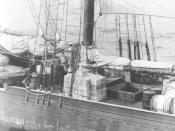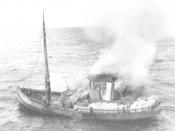Crime throughout the 1900's has appeared in different forms, but there was just as much of it as there is today. When the government banned alcohol in the early 1900's, illegal smuggling operations called rumrunning began. When the availability of consumer goods was being restricted in the World War II era, the black market was introduced. Juvenile delinquency has always been a problem in Canada but was the worst from the mid-to-late 1900's. Organized crime was just as much of a problem in the twentieth century as it is right now.
In the early 1900's, around the time of World War One, alcohol in the U.S. and Canada was prohibited. This was one of the greatest money-making opportunities of the 1920's for Canadians. When the manufacture, sale, transportation, importation, and exportation of liquor was banned in the United States, they naturally turned to Canada, and Canadians were more than willing to take advantage of the opportunity.
One example was the Bronfman family. They were involved with at least 8 bootlegging operations (Carrigan, 1991). Rumrunners like Henry Bronfman would bribe customs officials to "turn a blind eye" to any illegal activity going on with the company. Some officers would even assist in the bootlegging. For example, one officer from the Detroit-Windsor border (the most popular transfer spot for rumrunners) admitted that between 1935 and 1936 he allowed close to 200 carloads of liquor across the border (Carrigan, 1991). By July of 1920, smugglers were moving 1000 cases of whiskey a day from Windsor to Detroit (Staunton, 2006). They used boats in the summer, but in winter, they drove old, beat-up jalopies across the ice with the doors open (that way, if the ice broke, they could jump out and the loss of the car wasn't too great). This area was known...


